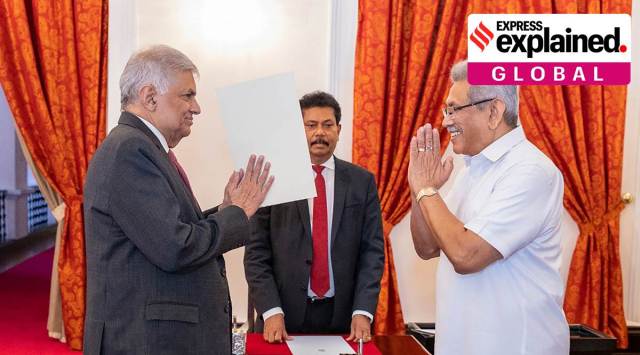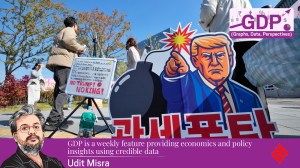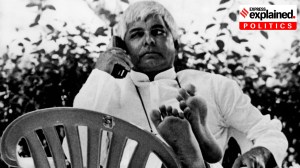Explained: Ranil and the Rajapaksas
As President Ranil Wickremesinghe starts on the most difficult assignment of his long political career, his greatest challenge will be to convince Sri Lankans that he is not a proxy for the Rajapaksa clan.
 Then President Gotabaya Rajapaksa (right) greets Ranil Wickremesinghe, then Prime Minister, in May 2022 in Colombo. (AP/PTI)
Then President Gotabaya Rajapaksa (right) greets Ranil Wickremesinghe, then Prime Minister, in May 2022 in Colombo. (AP/PTI)At the end of 2018, Mangala Samaraweera, then the Media Minister in the tottering National Unity Government of Prime Minister Ranil Wickremesinghe and President Maithripala Sirisena, made a remark that set off political ripples. As the government struggled to stay alive against the machinations of Mahinda Rajapaksa who was on the comeback trail and threatening to topple it, Samaraweera, who died last year, said: “… If we hadn’t won, Mahinda Rajapaksa would never have been able to go overseas. He would have been arrested. Mahinda Rajapaksa should actually light a lamp and worship Ranil Wickremesinghe every day. If he likes, he can even hang my picture next to the Prime Minister’s picture and worship. Because we saved him from becoming identified as an international assassin… ” (newsfirst.lk)
Samaraweera, an arch political foe of the Rajapaksas, was unlikely to have intended this remark to go down as a “secret alliance” or understanding between Wicrkremesinghe and the Rajapaksas. But long before then, in fact within months of entering office in 2015, Wicrkremesinghe was already seen as dragging his feet on the corruption investigations against the Rajapaksas. He appeared disinterested in the newly set up Financial Crimes Investigation Division, a separate unit in the police that had a mandate to investigate corruption cases. Nor was there much progress in the criminal investigation into the killing of journalist Lasantha Wickremtunge.
There were media reports too that the government had not followed up on inputs by western agencies on shipments of foreign currency notes out of Sri Lanka. Among civil society groups that had worked hard to put the Sirisena-Wickremesinghe “Yahapalanaya” (good governance) government in office, there was disappointment that the government had failed to proceed vigorously against the Rajapaksas as it had promised.
Sirisena, whose own political longevity depended on the government acting swiftly to put the Rajapaksas behind bars, also lost interest in keeping his rebellion against them alive, and decided that his own interests lay in burying the hatchet and accepting Mahinda’s leadership again.
This is why Wickremsinghe’s street cred has been so low. Just like his prime ministership, his win in Wednesday’s presidential election was built on the back of the Rajapaksa family party’s parliamentary numbers. In the eyes of many, this only deepens a discredited association, despite Wickremesinghe’s efforts over the last few days to put distance between himself and the ousted dynasty. Very few would expect that despite his vast powers as President, he will hold Gotabaya, Mahinda or any of the other Rajapaksas accountable for their alleged misdeeds. Instead, the more widespread belief is that they will once again get a free pass.
***
Two decades ago, no one in Sri Lanka would have described Ranil Wickremesinghe as a stooge of the Rajapaksas.
Both Wickremesinghe and Mahinda Rajapaksa have been in Sri Lanka’s public life through four decades, most of which coincided with a brutal ethnic conflict that claimed the lives of many of their colleagues. But they have little else in common. A fourth-generation politician from southern Sri Lanka, Rajapaksa was an influential power centre in the Sri Lanka Freedom Party (SLFP), but Chandrika Kumaratunga was still the party leader and President of Sri Lanka. Rajapaksa had to work his way to the top of the party.
Wickremesinghe came into the leadership of the United National Party (UNP) after the Tamil Tigers took out party leaders Ranasinghe Premadasa in 1993, and Gamini Dissanayake in 1994. After leading the UNP to its only election win — in the 2001 parliamentary polls — Wickremesinghe, a member of the Colombo upper class elite like Kumaratunga, was her Prime Minister. Their uneasy co-habitation government lasted just two years.
After that Wickremesinghe lost a string of elections, including the 2004 parliamentary elections and a 2005 bid for the presidency to Rajapaksa. Soon, several UNP heavyweight defected to the SLFP.
As the country rallied behind the Rajapaksa war effort against the Tamil Tigers, there was concern within the UNP at the leadership’s failure to carve out political space among the Sinahla-Buddhist majority. Instead, Wickremesinghe, who had negotiated a ceasefire with the Tigers in 2001, was dismissive of the Rajapaksa military campaign.
The haemorrhage in the UNP continued after the military defeat of the Tigers. The UNP was trounced in the 2009 parliamentary elections, and although Wickremesinghe did not contest the 2010 presidential election, Rajapaksa won again, easily defeating the common opposition candidate, the former Army chief Sarath Fonseka.
As the UNP licked its wounds, Sajith Premadasa led a call from within the party for a change of leadership. It was the UNP’s most serious crisis, but Wickremesinghe managed to get on top of it. What likely saved the day for him then was a dialogue initiated just then between the UNP, which was the main opposition party, and the Mahinda Rajapaksa-led government on proposed constitutional reforms. Rajapaksa held talks with Wickremesinghe, as if there was no leadership crisis in the party. The rebellion lost steam.
The talk then was that Rajapaksa and Ranil had a “I scratch your back, you scratch mine” deal. Rajapaksa wanted to prevent Sajith from rising to the top in the UNP because he did not want a challenger to his son Namal, who he had then begun grooming for politics.
A friend of both Rajapaksa and Wickremesinghe pointed out that as Prime Minister in 2015, Wickremesinghe had led chants of “Kowda Hora, Mahinda Hora (who is a rougue, Mahinda is a rogue)” in the House at a time that Rajapaksa was the leader of the Opposition. He said both had a healthy respect for each other’s political acumen.
***
On Thursday, Wickremesinghe declared that “I am not a friend of the Rajapaksas. I am a friend of the people of Sri Lanka”. Sri Lanka will be waiting to see how he substantiates that claim.
While the economic crisis looms large and will need all his attention, his political credibility – not high at the moment — will depend on how he deals with the Rajapaksas. After his appointment as Prime Minister by Gotabaya, Sri Lankan media had reported the two had fallen out over cabinet appointments, and were not on the same page on several crucial matters.
Wickremsinghe will also be watched as to how he deploys the President’s powers. The demand to abolish the executive presidency had much resonance during the three-month-long aragalaya against the Rajapaksas. Wickremesinghe has promised to reform it, but it has been a feature of the Sri Lankan presidency that every President bar one – D B Wijetunge in 1993 – has grown into the powers that it vests in them.



- 01
- 02
- 03
- 04
- 05


































